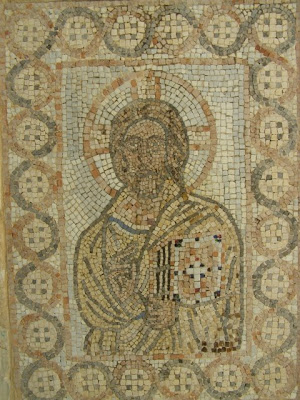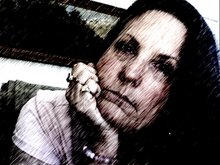
It’s so funny how things come back to bite you in the derriere – NOT! Every year for Palm Sunday the Music Director of my former congregation, in cooperation with the choir and one of the soloist would sing a piece that I disliked, ALOT. The piece, The Holy City by Stephen Adams and Richard Crooks was loved by many congregants and even requested! In addition to the palms waving in the air The Holy City was a staple at our Palm Sunday services.
To me it sounded schmaltzy, calliope-ish, and old fashioned. When it began I no longer saw the soloist in his fine red choir robe but standing there with a handlebar mustache and red stripped vest belting out or maybe even bleating the refrain “Jerusalem, Jerusalem, lift up your gates and sing, Hosanna through the ages, Hosanna to your King.” When the piece began I would look at my colleague and very discreetly roll my eyes up into my head.
Well, I got bit tonight here in that Holy City, Jerusalem. It was, as usual, a stunning evening in Jerusalem. The heat of the day dissipated and the cool breeze set in. A few stars popped out in the evening sky as we sat in the Tomb of the Kings in East Jerusalem. The history of the Tomb goes back to 45 CE when the Queen of Mesopotamia fell in love with Jerusalem and decided that it was here she wanted to bury her son. The tombs were cut into the rock and included a cave with a decorated façade. We sat surrounded by the high walls of the tombs which served as a memorial structure used for ceremonies. And it is here that the Palestine Youth Orchestra gave a beautiful concert as part of the Jerusalem Festival 08.
The Palestine Youth Orchestra brings together Palestinian musicians from around the world comprised of 50 young people residing in Palestine, Jordan, Syria, the USA and Europe. This was the first year in their five year history that they were able to perform in their homeland due to restrictions on entry. The first half of the program included excerpts from Aram Khachaturian’s Gayane Ballet Suite No 2 and 3. Everyone got fired up when they began to play Sabre Dance from the Suite.
The second half of the program featured Palestinian orchestral music celebrating Jerusalem. The three female vocalists were of opera caliber. Their voices blended so beautifully with the orchestra that I got chills. All of the pieces were sung in Arabic except for one song. You guessed it, The Holy City.
OK, it got to me. I admit it. I guess sometimes you’ve just ‘got to be there’ to understand. I have a whole new appreciation for this song because I can see and understand and picture in my mind’s eye the gates rising and the people singing Hosanna to our King. You can
listen to an excerpt if you aren’t familiar with the piece. It still sounds like it needs a calliope accompaniment but not so much now anymore. Now I understand the power of the words and the grand, imposing sound of the notes.
Excuse me now while I go to bandage a festering wound.

.JPG)
 Main city circle
Main city circle The logo to the Nablus soap factory. Nablus is very famous for its olive oil soap. At one point in time there were over 400 factories but today there are very few left. They are family owned.
The logo to the Nablus soap factory. Nablus is very famous for its olive oil soap. At one point in time there were over 400 factories but today there are very few left. They are family owned. A vat of liquid olive oil soap
A vat of liquid olive oil soap Pouring the hot soap
Pouring the hot soap Scoring the soap and putting on the logo
Scoring the soap and putting on the logo Scored soap stacked and ready for packaging
Scored soap stacked and ready for packaging Palestinians have an unusual way of using manniquins
Palestinians have an unusual way of using manniquins Through the alleys of the old city
Through the alleys of the old city See what I mean
See what I mean These two men wanted so badly to talk with us. It is unusual to see non-Palestinians in Nablus. Their English was much better than my Arabic. We could communicate with laughter.
These two men wanted so badly to talk with us. It is unusual to see non-Palestinians in Nablus. Their English was much better than my Arabic. We could communicate with laughter. These two young men wanted very badly to have their picture taken. I obliged. They are standing in front of a memorial.
These two young men wanted very badly to have their picture taken. I obliged. They are standing in front of a memorial. Every guide has his or her own favorite shops to visit. This was a spice and coffee shop. Arabs are known for their incredible hospitality. We sat down and had arabic coffee before cutting any deals.
Every guide has his or her own favorite shops to visit. This was a spice and coffee shop. Arabs are known for their incredible hospitality. We sat down and had arabic coffee before cutting any deals. Freshly roasted coffee being ground. I bought some to bring home...now if I only had the knack for cooking the coffee.
Freshly roasted coffee being ground. I bought some to bring home...now if I only had the knack for cooking the coffee. Umm, smell the aroma
Umm, smell the aroma Al Karreoun is one of the oldest neighborhoods in Nablus
Al Karreoun is one of the oldest neighborhoods in Nablus
 We stopped at a functioning Turkish bath. This is the waiting room where we sat and drank coffee. The clients come and relax beforehand and smoke argilla aka water pipes. The tobacco is flavored and delicious
We stopped at a functioning Turkish bath. This is the waiting room where we sat and drank coffee. The clients come and relax beforehand and smoke argilla aka water pipes. The tobacco is flavored and delicious Inside the bath....the women get Tuesday afternoon other than that the rest of the time is for men. Hey-it's the Middle East, what can I say?
Inside the bath....the women get Tuesday afternoon other than that the rest of the time is for men. Hey-it's the Middle East, what can I say?

















 This boy was painted up for the day. Here his is sipping fresh juice.
This boy was painted up for the day. Here his is sipping fresh juice.










.JPG)






